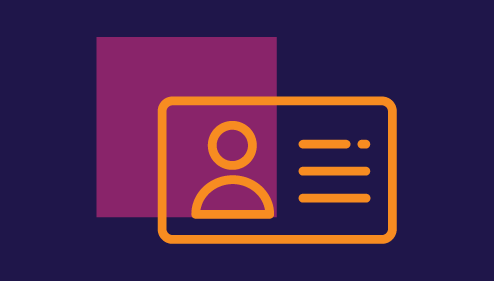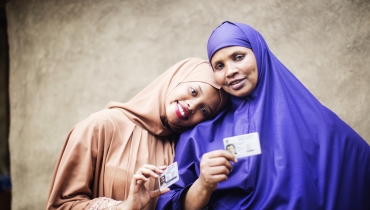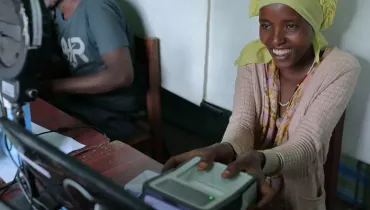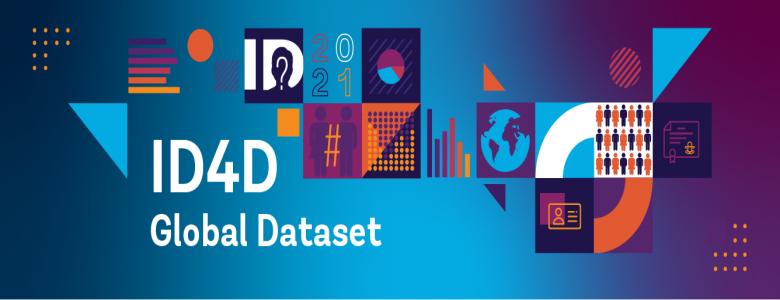Overview

Being able to prove who you are matters. Identification is a right, an instrument of protection, and a gateway to access services, benefits, and opportunities. Yet, many people around the world —particularly those living in lower-income countries and members of marginalized and vulnerable groups— do not have official identification to prove who they are. There are even more people who have an ID, but one that comes with many limitations regarding its design, verifiability, and use. Systems that provide people with identity credentials – whether for use in-person or online – are not always inclusive, trusted, or fit for purpose.
To tackle this challenge, it is important for the global community to gain a clearer view of who does and does not have an official ID and the features of ID systems and credentials globally. Since 2016, ID4D has produced global ID coverage estimates and data to help fill the gap on the number of people without proof of identity. New data collection efforts from 2021 onward have made it possible to provide more accurate and more disaggregated data on not only the ID coverage gap, but to also map ID systems’ digital capabilities [and additional features related to registration policies and processes, credential issuance, and use].
The latest edition of the ID4D Global Dataset indicates that approximately 850 million people around the world do not have an official ID. Many more do not have digitally verifiable identification. This includes at least 1.1. billion people who do not have a digital record of their identity; at least 1.25 billion people do not have a digitally verifiable identity; and at least 3.3 billion people do not have access to a government-recognized digital identity to securely transact online.
Reports
Global ID Coverage Estimates Report (Vol1) | Global Digital ID Capabilities Report (Vol2) | Trends in Identification for Development (Vol3) | Download the Data
Data
Download the ID & Digital ID Coverage Data | Download the ID System Features Data | Download the ID System Features Codebook
Global ID Coverage
Download the Report | Download the Data | Download previous Datasets
Globally, an estimated 850 million people do not have official identification—primarily people in lower-income countries and marginalized and vulnerable groups.
- Most people without an ID live in low-income (LIC) and lower-middle-income (LMIC) economies in Sub-Saharan Africa and South Asia.
- Over half the population without official identification are children whose births have not been registered.
- Women living in LICs are 8 percentage points less likely to have an ID than men, although some improvements have been made in the gender gap in some economies over the last four years.
- The gap in ID ownership is also significant for other vulnerable groups: adults in LICs are less likely to have an ID when they are below 25 years old, have only primary schooling or less, are out of the workforce, are in the bottom 40 percent of the income distribution, and live in rural areas.
Multiple barriers contribute to difficulties obtaining an ID.
- Among adults living in low-income countries (LICs), the most frequently cited reason for not having an ID was documentary requirements (46 percent), followed by distance to registration points (44 percent), and high cost (40 percent).
- Such issues are compounded when cumbersome registration procedures require multiple visits, either by design or due to problems with understaffing or absenteeism, long-wait times, unclear policies or procedures, or technical failures.
Not having an ID can negatively impact people’s access to services and fulfillment of rights.
- Globally, around 1 in 3 of those without an ID reported difficulty using financial services, receiving financial support from the government, applying for a job, and voting in elections.
- Nearly 40 percent of those without an ID reported difficulties obtaining a SIM card or mobile phone service, while around 25 percent had problems receiving medical care.
Digital ID Capabilities
Download the Report | Download the Data
More than 90 of countries now have foundational ID systems underpinned by digital data.
- As of mid-2022, 186 (out of 198) countries have a foundational ID system where identity records are stored in a digital format.
- Around 375 million people still live in countries where identity records are predominantly paper-based, making them difficult or impossible to verify or replace, and susceptible to damage, loss, or fraud.
- Many countries that, as of recently, were primarily reliant on paper-based identity records are in the process of introducing digitized ID systems. The number of people relying on non-digitized systems and records for identity management is expected to decline rapidly in the coming years.
Two-thirds of countries globally have foundational ID systems that support some form of digital identity verification and/or authentication for in person services and transactions.
- Foundational ID systems in at least 132 countries support some form of digital identity verification or authentication in the context of in-person services and transactions.
- Around 635 million people live in countries where identities cannot be verified or authenticated through digital means, and 270 million more live in countries where the availability of such services is unknown.
- For these people—and many more in countries where the accessibility and use of such services is uneven—the ability to securely verify a person’s legal identity is limited.
- The functionality, availability, and use of digital verification or authentication services—along with the levels of assurance and data privacy and protection safeguards they provide—varies substantially across countries.
In close to 40 percent of countries, people can obtain at least one government-recognized digital identity credential— i.e., one that allows for remote authentication to access online services and transactions.
- In 81 countries (51 of which are high-income), people can obtain at least one government-recognized digital identity credential that allows for remote authentication to access online services and transactions. T
- Over 3.3 billion people (or 2.2 billion people over the age of 15) live in countries without an option to prove their official identity online.
- Even in countries where an online digital identity solution is available, their use varies significantly, from very high uptake in Scandinavian countries and Estonia, to far fewer users per capita in much of Latin America, Central Asia, and some European countries like Germany.
When combined with data on the number of people without any official proof of identity, these findings suggest that, in addition to the 850 million people without any ID, at least:
- 1.1 billion people do not have a digital record of their identity;
- 1.25 billion people do not have a digitally verifiable identity; and
- 3.3 billion people do not have access to a government-recognized digital identity to securely transact online
Trends in ID Systems
Download the Report | Download the Data | Download the Codebook
Designing inclusive and effective digital ID requires a strong understanding of the current ID ecosystem to build on past successes and avoid potential missteps. The third volume of the ID4D Global Dataset 2021 takes stock of the world’s foundational ID systems, diving deep into their policies, technologies, and operations, to offer a benchmarking tool and a new repository of information for ID practitioners and stakeholders.
Data and indicators in this paper are organized according to the major stages of the identity lifecycle: registration, issuance, use, and management.
Management
- We only know of six countries in which the “ID Authority” (our term for the government entity that owns and manages the ID system) is completely independent. In other cases, the ID Authority is housed within a “home institution” elsewhere in the government.
- The most common type of home institution is a Ministry of Interior or Home Affairs (at least 93 countries).
Registration
- Registration and obtaining an ID is mandatory for nationals is mandatory in at least 129 countries.
- Non-nationals are eligible to register in the foundational ID system in at least 94 countries, or over half of countries globally.
- The first credential issued is completely free in 63 countries, but replacement IDs are less likely to be free—only 15 countries that we know of issue free replacement credentials in all circumstances.
- To establish a person’s identity during registration in the ID system, virtually all ID systems collect name, date of birth, and gender or sex (collection of other biographic details varies). In addition to biographic data, most foundational ID systems (at least 152) collect biometrics, and most commonly fingerprints and facial images.
- The identity claim stage typically also involves documentation, and one of the most required documents is a birth certificate. In at least 90 out of 175 countries, everyone is required to present their birth certificate during registration. In an additional 26 countries a birth certificate is one of multiple accepted documents for establishing identity. However, at least 60 countries offer alternative processes for individuals who do not have the commonly required documents.
Issuance
- In any foundational ID system, identifying numbers are the most basic type of identifier or credential. Most countries (at least 134 out of 175) issue an ID number that is considered “permanent” (i.e., unchanging throughout a person’s lifetime). These numbers range in length from 7 to 20 digits, but most are around 10 to 13 digits.
- Only 21 countries that we know of generate completely random ID numbers. The most common ID number format, issued by at least 54 countries, is a mix of coded and sequential digits.
- At least 86 countries issued their ID number to newborns at birth, and many of these (at least 58) print the newborn’s ID number on their birth certificate.
- Despite the rapid growth of digital credentials, physical credentials still play an important role in ID systems. These often (though not always) consist of an ID card, generally known as a “national ID” or a similar term. The majority of countries issue ID cards made of plastic (at least 125 out of 175), while at least 14 issue paper-based credentials.
- The most common digital data storage feature that these cards have is a chip (seen in at least 100 countries). At least 46 countries’ cards have 2D barcodes like QR codes—sometimes in addition to a chip.
Use
- The data indicate that it is more common for service providers to accept their country’s national ID as one of multiple options for proof of identity, rather than to mandate that the national ID specifically must be used. The service in our study with the highest rate of requiring the national ID is bank account opening: to open an account at a bank or financial institution, 65 countries (out of 73 for which we have data) require the national ID, while another 10 accept it as one of multiple ID options.
- Most ID systems offer some level of digital verification and/or authentication mechanisms beyond presenting a credential for visual inspection. When it comes to biometrics, the data suggests that fingerprints are the most common modality used for digital authentication. Of the 134 countries that we know collect fingerprint data, 54 reporting using it for verification and/or authentication (while 13 out of the 134 countries specifically do not).
Forward Look

Data collection is underway for the next round of this series, ID4D Global Dataset 2024. Visit this page mid-2025 for its release, including the first global survey data on Digital ID access and use.
Read More

Principles on Identification
Ensuring universal access to identification, from birth to death, is Principle #1. To explore all, visit: https://www.idprinciples.org/.

850 million people globally don’t have ID—why this matters and what we can do about it
Imagine not being able to prove who you are—no birth certificate, no passport, no driver’s license or national ID.

Beyond Coverage
Explore ID4D’s research and publications on improving accessibility, data protection, the responsible use of digital technology and much more.


